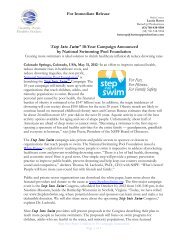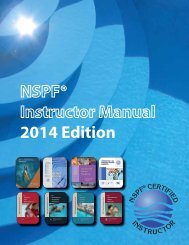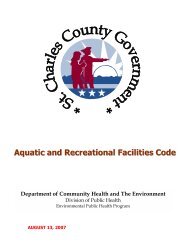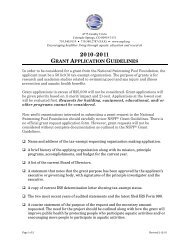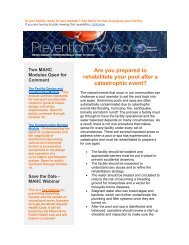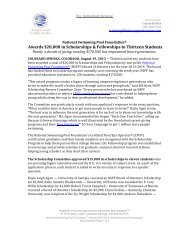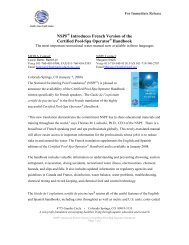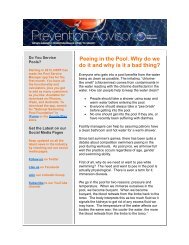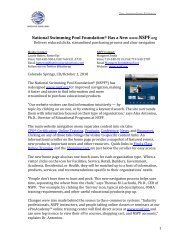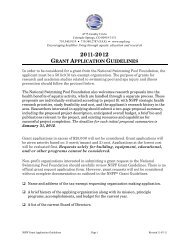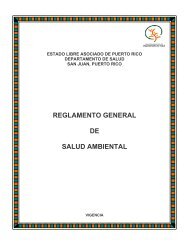English Instructor Manual (PDF) - Metric Version - National ...
English Instructor Manual (PDF) - Metric Version - National ...
English Instructor Manual (PDF) - Metric Version - National ...
You also want an ePaper? Increase the reach of your titles
YUMPU automatically turns print PDFs into web optimized ePapers that Google loves.
Briefl y discuss the three advantages heat pumps with scroll compressors<br />
Defi ne coeffi cient of performance<br />
Activity: Using Appendix J - Calculation Formulas, do several heater sizing calculations.<br />
Key Points: Discuss ways to prevent energy loss. These include:<br />
In outdoor pools, shelters such as trees, fences, plants, etc. help reduce convection and<br />
evaporation energy loss due to wind.<br />
In indoor pools, control air-to-water temperature differences. To keep heat in the water,<br />
the air temperature should be between 1°-2.5°C warmer than the water.<br />
In indoor pools, control relative humidity. Relative humidity should be maintained<br />
between 40% to 60%.<br />
Covers reduce the loss of energy due to convection, radiation, and evaporation by about<br />
50% to 70%.<br />
Key Points: Explain that, for indoor pools, proper air circulation is as important as proper water<br />
circulation. For example, during breakpoint chlorination, waste and by-product gasses evaporate<br />
into the air directly above the water. If poor air circulation does not remove these gasses, they will<br />
dissolve back into the pool water, drastically increasing the combined chlorine levels of the water<br />
and making the breakpoint chlorination process useless.<br />
Discuss the considerations for designing proper air circulation. These include:<br />
Humidity control.<br />
Ventilation requirements for air quality (outdoor and exhaust air). Be sure to follow the<br />
ASHRAE requirement of 2.4 litres per second per square metre of pool and deck area<br />
Air distribution.<br />
Air duct design.<br />
Evaporation rates.<br />
Pool water chemistry.<br />
Key Points: Discuss the operation recommendations for air control systems. These include:<br />
Maintain relative humidity between 40%-60%. Less than 40% makes the air too dry<br />
and increases evaporation. More than 60% encourages condensation and corrosion<br />
problems.<br />
Maintain the air temperature between 1°-2.5°C greater than the water temperature.<br />
Air velocity should not exceed 0.13 metres/second a point 2.4 metres above the walking<br />
deck. Any faster creates a “breeze” that may cause discomfort to swimmers. Any slower<br />
will not be suffi cient to remove waste and by-product gasses.<br />
Since re-circulated air contains waste and by-product gasses, suffi cient outdoor air must<br />
be mixed with the indoor air to keep it fresh. Most recommendations suggest at least<br />
a 50% mix of fresh air and recirculated air. When outside temperatures allow, 100%<br />
outside air is preferred.<br />
The entire volume of air should recirculate four to six times an hour.<br />
Recommend that students enroll in and take the Indoor Air Quality online course from<br />
NSPF.<br />
Final Questions: Ask the participants if they have any questions pertaining to the lesson they<br />
have just completed. If there are participants who are still having trouble with the concepts of this<br />
lesson, offer additional help during a break or after class.<br />
Page 80<br />
© 2014 <strong>National</strong> Swimming Pool Foundation®



